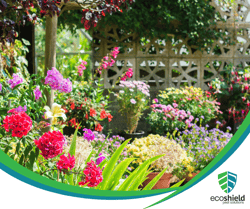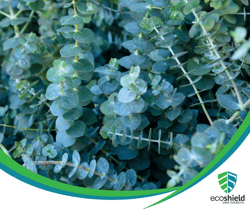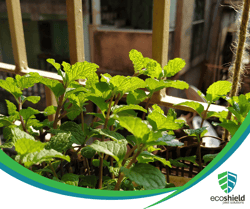 As homeowners, we empathize with the frustration of battling unwanted critters invading your outdoor spaces, disrupting the tranquility we strive to cultivate. That's why we've meticulously curated a comprehensive list of resilient botanical beauties that serve not only to enhance your garden's aesthetics but also to naturally repel pests, providing you with a harmonious and pest-free environment to relish year-round. From aromatic herbs to vibrant flowers, these carefully selected plants offer a dual benefit: they beautify your outdoor space while serving as nature's own pest control agents. Join us on this journey of discovery as we uncover the secrets of creating a serene outdoor sanctuary for you and your family, where pest-free living doesn’t have to be sacrificed.
As homeowners, we empathize with the frustration of battling unwanted critters invading your outdoor spaces, disrupting the tranquility we strive to cultivate. That's why we've meticulously curated a comprehensive list of resilient botanical beauties that serve not only to enhance your garden's aesthetics but also to naturally repel pests, providing you with a harmonious and pest-free environment to relish year-round. From aromatic herbs to vibrant flowers, these carefully selected plants offer a dual benefit: they beautify your outdoor space while serving as nature's own pest control agents. Join us on this journey of discovery as we uncover the secrets of creating a serene outdoor sanctuary for you and your family, where pest-free living doesn’t have to be sacrificed.
How do gardens and landscaping contribute to pest problems?
Gardens and home landscaping, while adding beauty and tranquility to outdoor spaces, can inadvertently contribute to pest problems for homeowners. One primary way this happens is through the selection of plants that are highly attractive to pests. Certain flowers, fruits, and vegetables can act as magnets for pests such as aphids, caterpillars, and beetles. When these plants are introduced into a garden or landscaping design, they can attract pests that may then spread to other nearby plants, causing widespread infestations.
 Furthermore, the layout and design of gardens and landscaping can create ideal habitats for pests to thrive. Dense foliage, mulch beds, and overgrown areas provide shelter and hiding spots for pests, allowing them to reproduce and multiply rapidly. Additionally, stagnant water in poorly drained areas or in neglected containers can become breeding grounds for mosquitoes and other water-loving pests.
Furthermore, the layout and design of gardens and landscaping can create ideal habitats for pests to thrive. Dense foliage, mulch beds, and overgrown areas provide shelter and hiding spots for pests, allowing them to reproduce and multiply rapidly. Additionally, stagnant water in poorly drained areas or in neglected containers can become breeding grounds for mosquitoes and other water-loving pests.
Improper maintenance practices can also exacerbate pest problems in gardens and landscaping. Neglected plants that are not regularly pruned, weeded, or fertilized may become stressed and more susceptible to pest infestations. Overuse of chemical pesticides can disrupt the natural balance of beneficial insects and predators, leading to outbreaks of pest populations that are resistant to chemical control methods.
Moreover, the proximity of gardens and landscaping to the home itself can invite pests indoors. Pests such as ants, cockroaches, and rodents may find easy access to the house through overgrown shrubs, tree branches touching the roof, or cracks and gaps in the exterior walls. Once inside, these pests can pose health risks and cause damage to property.
.png?width=250&height=210&name=Home%20Landscaping%20(1).png) In summary, gardens and home landscaping have the potential to contribute to pest problems for homeowners through the selection of pest-attractive plants, the creation of ideal habitats for pests, improper maintenance practices, and the proximity to the home. However, with careful planning, regular maintenance, and the use of integrated pest management techniques, homeowners can minimize pest issues and enjoy their outdoor spaces to the fullest.
In summary, gardens and home landscaping have the potential to contribute to pest problems for homeowners through the selection of pest-attractive plants, the creation of ideal habitats for pests, improper maintenance practices, and the proximity to the home. However, with careful planning, regular maintenance, and the use of integrated pest management techniques, homeowners can minimize pest issues and enjoy their outdoor spaces to the fullest.
What types of plants are most attractive to pests?
Certain types of plants are more prone to pest infestations due to various factors such as their scent, texture, and nutrient composition. Understanding these factors can help homeowners identify and address potential pest problems in their gardens.
 One category of plants that commonly attracts pests is those with succulent, tender foliage. For instance, members of the Solanaceae family, including tomatoes, peppers, and eggplants, are susceptible to pests like aphids, whiteflies, and tomato hornworms. These pests are drawn to these plants' tender leaves and stems, providing them with a readily available food source. Additionally, plants with soft, succulent foliage, such as lettuce and spinach, are also attractive to pests like slugs and snails, which can quickly decimate a crop if left unchecked.
One category of plants that commonly attracts pests is those with succulent, tender foliage. For instance, members of the Solanaceae family, including tomatoes, peppers, and eggplants, are susceptible to pests like aphids, whiteflies, and tomato hornworms. These pests are drawn to these plants' tender leaves and stems, providing them with a readily available food source. Additionally, plants with soft, succulent foliage, such as lettuce and spinach, are also attractive to pests like slugs and snails, which can quickly decimate a crop if left unchecked.
Another group of plants that tends to attract pests is those with fragrant flowers or foliage. While these plants may be pleasing to humans, they can also act as a beacon for pests such as thrips, which are attracted to the scent of flowers. Roses, for example, are notorious for attracting aphids due to their sweet fragrance, while marigolds are often targeted by spider mites. Even herbs like basil and mint, prized for their aromatic leaves, can fall victim to pest infestations, with basil attracting pests like aphids and whiteflies and mint being susceptible to spider mites and aphids.
 Plants that produce sugary substances, such as nectar or sap, are also prime targets for pests seeking a quick source of energy. Fruit trees like apple and peach trees, for instance, can attract pests like fruit flies and codling moths, which are drawn to the sweet scent of ripening fruit. Similarly, ornamental plants like roses and hibiscus, which produce sugary nectar to attract pollinators, can also attract pests such as ants and aphids.
Plants that produce sugary substances, such as nectar or sap, are also prime targets for pests seeking a quick source of energy. Fruit trees like apple and peach trees, for instance, can attract pests like fruit flies and codling moths, which are drawn to the sweet scent of ripening fruit. Similarly, ornamental plants like roses and hibiscus, which produce sugary nectar to attract pollinators, can also attract pests such as ants and aphids.
Finally, plants that are stressed or weakened due to environmental factors are more susceptible to pest infestations. Drought-stressed plants, for example, may produce less sap, making them less attractive to pests, while overwatered plants may become more vulnerable to fungal diseases and root rot, which can attract pests like fungus gnats and root aphids.
Are there plants that naturally repel pests?
Yes, there are indeed plants that possess natural repellent properties against pests, offering homeowners an eco-friendly and chemical-free solution to pest control. These plants often contain compounds that emit strong odors, produce substances that deter pests, or have physical characteristics that make them less appealing to insects.
 One prime example of a plant known for its pest-repelling qualities is the marigold (Tagetes spp.). Marigolds emit a pungent scent that deters many pests, including aphids, nematodes, and whiteflies. Additionally, they produce allelochemicals, such as thiophenes, which can inhibit the growth of certain soil-borne pests and pathogens. Planting marigolds around vegetable gardens or in flower beds can help reduce pest pressure and promote healthier plant growth.
One prime example of a plant known for its pest-repelling qualities is the marigold (Tagetes spp.). Marigolds emit a pungent scent that deters many pests, including aphids, nematodes, and whiteflies. Additionally, they produce allelochemicals, such as thiophenes, which can inhibit the growth of certain soil-borne pests and pathogens. Planting marigolds around vegetable gardens or in flower beds can help reduce pest pressure and promote healthier plant growth.
Another well-known pest-repellent plant is lavender (Lavandula spp.). Lavender's strong fragrance acts as a natural deterrent to pests like mosquitoes, flies, moths, and fleas. Its aromatic oils contain compounds such as linalool and linalyl acetate, which not only repel pests but also have calming effects on humans. Planting lavender near outdoor seating areas or entry points to the home can help keep pesky insects at bay while adding beauty and fragrance to the landscape.
Rosemary (Rosmarinus officinalis) is another herbaceous plant celebrated for its pest-repellent properties. Its woody stems and needle-like leaves contain volatile oils, including camphor and cineole, which repel a variety of pests, including mosquitoes, flies, and cabbage moths. Rosemary can be grown in pots on patios or near windows to deter flying insects or planted in vegetable gardens to protect crops from pest damage.
 Mint (Mentha spp.) is renowned for its aromatic leaves and vigorous growth habit, but it also serves as a natural pest repellent. The strong scent of mint is effective at repelling pests like ants, rodents, and aphids. Peppermint oil, derived from the leaves of the plant, is commonly used in natural pest control solutions for its potent repellent properties. Planting mint in pots around the perimeter of the garden or near entryways can help discourage pests from invading indoor and outdoor spaces.
Mint (Mentha spp.) is renowned for its aromatic leaves and vigorous growth habit, but it also serves as a natural pest repellent. The strong scent of mint is effective at repelling pests like ants, rodents, and aphids. Peppermint oil, derived from the leaves of the plant, is commonly used in natural pest control solutions for its potent repellent properties. Planting mint in pots around the perimeter of the garden or near entryways can help discourage pests from invading indoor and outdoor spaces.
Chrysanthemums (Chrysanthemum spp.) contain a natural insecticide called pyrethrin, which is commonly used in commercial pest control products. Pyrethrin is effective against a wide range of pests, including ants, roaches, beetles, and mosquitoes, making chrysanthemums an excellent choice for natural pest management. Planting chrysanthemums in flower beds or containers around the home can help repel pests while adding vibrant color to the landscape.
Can certain trees or shrubbery deter pests?
Yes! One notable example of a tree with pest-deterring properties is the neem tree (Azadirachta indica). Neem is renowned for its potent insect-repelling qualities, thanks to the presence of compounds like azadirachtin, nimbin, and salannin in its leaves, seeds, and bark. These compounds have insecticidal, antifeedant, and growth-regulating properties that deter a wide range of pests, including mosquitoes, aphids, caterpillars, and beetles. Neem extract is commonly used in organic pest control products to repel and disrupt the life cycles of pests without harming beneficial insects or the environment.
Another tree known for its pest-deterring attributes is the cedar tree (Cedrus spp.). Cedar wood contains natural oils and compounds, such as thujone and cedrol, that repel insects and pests. Cedarwood chips or shavings are commonly used as a natural insect repellent in closets, drawers, and storage areas to deter moths, ants, and roaches. Planting cedar trees or shrubs around the perimeter of the property can create a natural barrier against pests and discourage them from entering the home or garden.
 Eucalyptus trees (Eucalyptus spp.) are valued not only for their aromatic foliage but also for their pest-repellent properties. Eucalyptus oil, extracted from the leaves of the tree, contains compounds like cineole and piperitone, which have insecticidal and insect-repellent effects. Eucalyptus oil is commonly used in natural insect repellent sprays and diffusers to repel mosquitoes, ticks, and fleas. Planting eucalyptus trees in the yard or garden can help deter pests while providing shade and visual interest to the landscape.
Eucalyptus trees (Eucalyptus spp.) are valued not only for their aromatic foliage but also for their pest-repellent properties. Eucalyptus oil, extracted from the leaves of the tree, contains compounds like cineole and piperitone, which have insecticidal and insect-repellent effects. Eucalyptus oil is commonly used in natural insect repellent sprays and diffusers to repel mosquitoes, ticks, and fleas. Planting eucalyptus trees in the yard or garden can help deter pests while providing shade and visual interest to the landscape.
Certain shrubs are also effective at deterring pests due to their physical characteristics or chemical properties. Boxwood (Buxus spp.), for example, is a dense evergreen shrub with thick foliage that creates a natural barrier against pests like deer and rabbits. Boxwood's dense growth habit and leathery leaves make it less appealing to browsing animals, helping to protect vulnerable plants in the garden.
Can using pest-resistant plants in your garden or landscaping help reduce pest problems for homeowners?
Using pest-resistant plants in your garden or landscaping can play a role in reducing pest problems for homeowners. These plants offer natural defenses against common pests, promote a healthier ecosystem, and contribute to sustainable gardening practices by minimizing the use of chemical pesticides. With that said, reliably preventing pests in and around your home with plants alone is not an effective pest management solution. To truly safeguard your home and family from pest activity, we highly recommend seeking the assistance of a trusted pest professional such as EcoShield. Give us a call or fill out the form on this page today to learn how EcoShield can prevent and protect your home from pests.